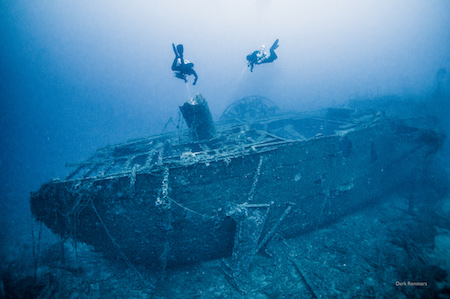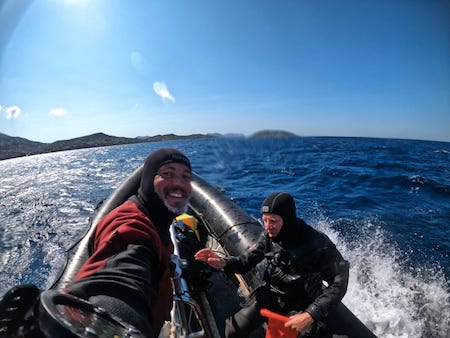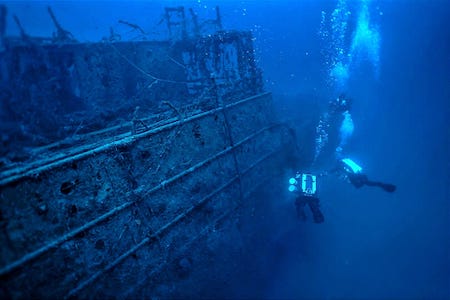Technical Dives
The Saronic Gulf is literally littered with both historic and commercial wrecks. So close to the main port of Piraeus and an important strategic area during both World War I and II, naval history awaits you! We offer bespoke technical diving trips in a friendly atmosphere focused on safety and excellent customer service. You certainly won’t get bored!
Scubalife is a pioneer in tech dive trips in the area and continues to offer tailor-made tech trips that get you really using your tech certifications.
Harnessing our in-depth local knowledge, technical diving know-how, and a decade of experience in the area, we will show you around our top technical dive sites.
Now that you have unlocked more time at depth, indulge yourself and come and explore the best tech wrecks in Greece, year-round, at your convenience. Alternatively, hop onto one of our Tech Wreck Weeks to experience the best technical diving in Athens.
If you are not yet a certified technical diver, you can train with us and get access to these trips!
Normoxic Trimix Dives
Diving at depths up to 60m for Normoxic Trimix certified divers and bottoms times according to your level and experience. Whether you have just been introduced to the tech diving realm, or are an old hand seeking to explore more and extend your experience this trip has what you are looking for . Join [Scubalife] on a dive journey into history. Visit WW1 and WW2 wrecks, deep one-of-a-kind topographic formations and see human artifacts from another time. Perfect for Tech beginners who want to build experience and see some fantastic wrecks and deep dive sites. Tech 1 wrecks are all located in the 15-20 NM range from our base. Usually one good, long dive a day, our possible dives include :
PSS PATRIS on SW Kea – a British-built paddle steamer sunk in 1868. The Patris was making for Syros Island but foundered on the reef in the dark. All four hundred passengers and crew were rescued. She now sits in two sections at 50m and 30m. She’s a sleeping beauty, covered with growth all along the rib-like structures.
CS RETRIEVER at Glyfada , a small cable layer ship that was bombed and sunk in 1941 by the German Luftwaffe during the invasion of Greece.
MV PYLAROS at Alimos marina – a motor ship sunk in 1976 while avoiding collision with another ship She sits at 35 – 52 metres.
AVANTIS III (one of our flagship dives) Dorousa Island, Aegina – She was built in 1977 as a cargo ship. On November 19th, 2004 en route from Messolonghi to Cyprus carrying construction materials and crew of 12, she hit the islet and sank with one casualty.
SS ORIA at Patroklos Island – a Norwegian steam ship that was used as a transport vessel for Italian POWs before sinking near the island of Patroklos after being caught in a storm. Although the ship was recovered for scrap in the 60s, there are many fascinating artifacts to see strewn about the seabed.
Hypoxic Trimix Dives
For those with Hypoxic Trimix certification and considerable experience, we have some really special dives for you.
On our Hypoxic Trimix Dive Trip, we’ll be diving up to 75m, or up to 90m if you have the designated depth on your certification and serious experience. One good, long dive per day, our possible dives include:
SS MONROSA – South of Arsida islet – An Italian steam cargo ship, she went down in 1941 having been struck by the British submarine HMS Triumph on her way to Piraeus. Accompanied by some defender ships, a short battle ensued, but the submarine managed to dive and get away. She is large and lies between 75-90m.
SS PATRIS (not to be confused with PSS PATRIS) Patroklos Island. The carrier Patris , built in England in 1902, was travelling from Piraeus to Naxos in June 1927 and collided with the carrier Moschanthi Togia sinking within 2 minutes. Eleven lives were lost. She lies at depths between 67 and 72m.
SS ROSA VLASI – between Makronissos and Lavrio “Rosa Vlassi” loaded with a cargo of 2900 tones of mixed ferro-silicon, left Piraeus on 24 December 1959. About a mile and a half south of Sounio, she started to incline at an angle of 40-45 degrees. The Captain broadcast a Mayday and the crew prepared for the worst. Captain lost control of the helm and the ship overturned and sank.
German submarine U-133 – NW Saronic Gulf German submarine U-133 was a Type VIIC U-boat built for Nazi Germany’s Kriegsmarine for service during World War II. She sank with all hands lost after striking a mine off Aegina island Greece on 14 March 1942.
SS BURDIGALA (flagship dive)- Kea Strait – Built as Ocean Liner S/S Kaiser Friedrich in 1897-1898 she was requisitioned by the French Government and used as transporter for the Dardanelle Campaign in 1914. On 14.11.1916 she struck a mine and sank off the island of Kea. A week later the HMHS Britannic sank two nautical miles far from her for the same reason. The mines were deployed by the German submarine U 73 in October 1916. The S/S Burdigala is the second largest wreck in the Greek Seas.
JUNKERS 52 – Kea Strait – Produced by the Junkers Company in Germany for the Luftwaffe, she took part in “Operation Mercury” (May 1941, Crete) and “Operation Barbarossa” (June 1941, Russia). She belonged to the First Group of the Transport Wing No. 4 (I/TG 4) of the Luftwaffe. On 6.9.1943 she was lost after ditching in the northwest sea of Kea, due to fuel supply problems. The Ju 52 of Kea is one of the best preserved Junkers 52 in the Greek Seas.



